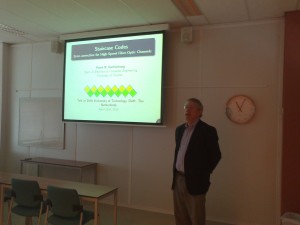On April 23, 2013, Prof. Frank Kschischang gave two lectures on coding. The first lecture was given at Delft University of Technology and the second lecture at ESTEC.
Detailed information on the lectures can be found below.
Lecture 1: Staircase Codes: Error-correction for High-Speed Fiber-Optic Channels
Location: Delft University of Technology, Faculty of Electrical Engineering, Mathematics and Computer Science, Mekelweg 4, 2628 CD, Delft, The Netherlands
Room: HB09.150 (located on the 9th floor)
Time: 11:00
Abstract:
We describe staircase codes, a new class of error-control codes suitable for high-speed optical communications. One sample design, targeted at 100Gb/s optical transport networks, yields an ITU-T G.709-compatible staircase code with rate R=239/255 for which FPGA-based simulation results exhibit a net coding gain (NCG) of 9.41 dB at an output error rate of 10^{-15}, an improvement of 0.42 dB relative to the best code from the ITU-T G.975.1 recommendation. An error floor analysis shows that this code has an error floor below 10^{-20}. These codes can be exploited in higher-order modulation schemes incorporating signal shaping, to achieve reliable communication near the estimated capacity of fiber channels. For example, one design yields a practically achievable spectral efficiency within 0.62 bits/s/Hz of the estimated capacity of a long-haul fiber channel having a length of 2000 km.
(Joint work with Benjamin Smith, Arash Farhood, Andrew Hunt, and John Lodge)
Lecture 2: An Algebraic Approach to Physical-Layer Network Coding
Location: ESTEC
Room: Newton 1
Time: 16:00
Abstract:
Physical-layer network coding schemes exploit the network coding operation that occurs naturally when interfering wireless communication signals superpose. Rather than treating interference as a nuisance, nodes in a wireless relay network attempt to decode useful linear combinations of messages from the received superposition of signals, even when the interfering signals cannot be disentangled individually.
As in traditional network coding, the receiver gathers such linear combinations, and decodes by solving a linear system. In this talk, the problem of designing physical-layer network coding schemes via nested lattices is considered. Building on the compute-and-forward relaying strategy of Nazer and Gastpar, who demonstrated its asymptotic gain using information-theoretic tools, an algebraic approach is taken to show its potential in non-asymptotic settings. The resulting scheme naturally leads to a linear network coding channel over modules. In the practically important case where the underlying ring is a finite chain ring, a matrix channel is obtained for which tight capacity bounds and polynomial-complexity capacity-achieving coding schemes can be obtained.
(Joint work with Chen Feng, Danilo Silva, and Roberto W. Nobrega)
Speaker:
Prof. Frank R. Kschischang
Department of Electrical and Computer Engineering
University of Toronto
Biography:
Frank R. Kschischang received the B.A.Sc. degree (with honors) from the University of British Columbia, Vancouver, BC, Canada, in 1985 and the M.A.Sc. and Ph.D. degrees from the University of Toronto, Toronto, ON, Canada, in 1988 and 1991, respectively, all in electrical engineering. He is a Professor of Electrical and Computer Engineering at the University of Toronto, where he has been a faculty member since 1991. During 1997-98, he was a visiting scientist at MIT, Cambridge, MA; in 2005 he was a visiting professor at the ETH, Zurich, and in 2011 and again in 2012/13 he was a visiting Hans Fischer Senior Fellow at the Institute for Advance Study at the Technical University of Munich.
His research interests are focused primarily on the area of channel coding techniques, applied to wireline, wireless and optical communication systems and networks. In 1999 he was a recipient of the Ontario Premier’s Excellence Research Award and in 2001 (renewed in 2008) he was awarded the Tier I Canada Research Chair in Communication Algorithms at the University of Toronto. In 2010 he was awarded the Killam Research Fellowship by the Canada Council for the Arts. Jointly with Ralf Koetter he received the 2010 Communications Society and Information Theory Society Joint Paper Award. He is a recipient of the 2012 Canadian Award in Telecommunications Research. He is a Fellow of IEEE, of the Engineering Institute of Canada, and of the Royal Society of Canada.
During 1997-2000, he served as an Associate Editor for Coding Theory for the IEEE TRANSACTIONS ON INFORMATION THEORY. He also served as technical program co-chair for the 2004 IEEE International Symposium on Information Theory (ISIT), Chicago, and as general co-chair for ISIT 2008, Toronto. He served as the 2010 President of the IEEE Information Theory Society.

